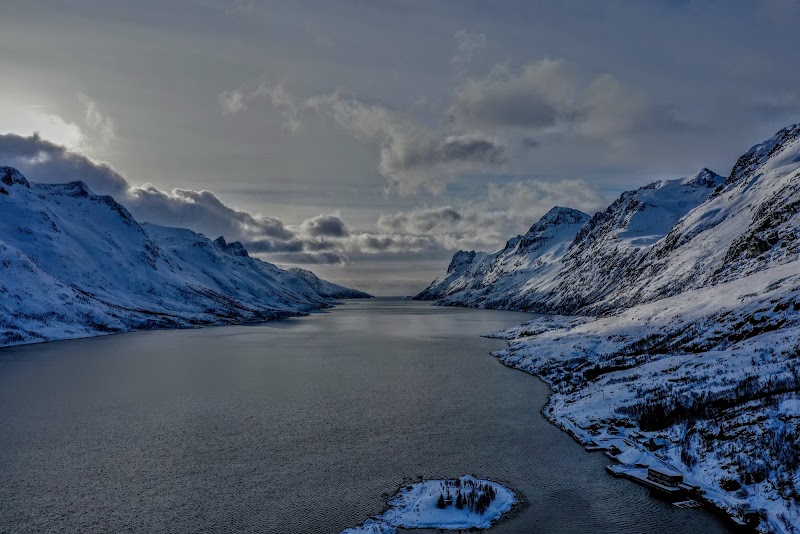Chasing the Northern Lights Across Tromsø’s Arctic Sky
Experience the thrill of chasing the Northern Lights in Tromsø, where Arctic night skies come alive with shifting colors. This practical guide provides everything you need—from trail details to seasonal tips—to prepare for one of nature’s most extraordinary shows.
Dress in Layers for Arctic Conditions
Temperatures drop sharply after sunset. Wear multiple layers with a moisture-wicking base, insulating mid-layer, and waterproof outer shell to stay warm and dry.
Choose Footwear with Traction
Trails may be icy or snowy; sturdy waterproof boots with good grip prevent slips and keep feet warm during extended waits outside.
Monitor Aurora and Weather Forecasts
Check updated geomagnetic activity reports and local weather for clear skies to maximize your chance of seeing the lights.
Bring a Headlamp with Red Light Mode
A red filter preserves night vision and allows safe navigation without disturbing the fragile darkness for others around you.
Chasing the Northern Lights Across Tromsø’s Arctic Sky
The Arctic sky above Tromsø awakens after dusk, a shifting canvas where the Northern Lights—aurora borealis—dance with fierce independence. To chase this phenomenon is to engage in a pursuit of nature’s raw spectacle, where the lights don’t perform for you but invite you to witness their unpredictable show. Tromsø, located above the Arctic Circle in Norway, stands as an ideal launchpad for this pursuit: its dark skies, accessible wilderness, and relatively mild coastal climate form the perfect backdrop.
The chase often begins with a short hike or a night drive away from city lights. Trails around Tromsø vary, from gentle forest paths to steep hills, with elevations typically ranging from 200 to 400 meters. For example, the hike to the summit of Tromsdalstinden is a popular option: 10 kilometers round trip with an elevation gain of roughly 1000 meters, offering an expansive view where the aurora frequently reveals itself. The terrain tests endurance but rewards with expansive Arctic vistas—bare rock faces, sparse birches, and patches of evergreen trees standing firm against the cold night.
As you move under the slowly ebbing twilight, the wind acts like an eager guide, pushing forward, carrying cold whispers from the fjords below. The sky roils with faint greens turning brighter, ribbons of purple weaving through. The lights challenge your patience and your gear. Warm layers, solid waterproof boots with grip for icy patches, and headlamps with red filters are essential tools. Staying hydrated and fueled is practical: keep water accessible and snacks handy to maintain energy against the cold’s sting.
Timing is crucial. The best season spans late September to early April, when the polar night offers the darkest skies. Cloud cover, weather fronts, and solar activity dictate success. Local guides track geomagnetic forecasts to position groups under the clearest arcs of cosmos.
Beyond simply watching, the chase invites interaction—reading the sky’s moods, selecting vantage points that maximize horizon views, and knowing when to press on or pause. Return paths through silent, frost-etched forests heighten the experience, each step crunching over snow or frozen brush, nature firmly asserting its presence.
To prepare: plan with flexible timings, dress in layers designed for cold, and allow for patience and unpredictability. The Northern Lights are not a guaranteed outcome but a fiercely wild force that demands respect.
Chasing the Northern Lights in Tromsø means embracing a night where adventure meets raw, elemental beauty. It’s not just a spectacle but a two-way conversation with the Arctic sky itself.
Nearby Trips
All Adventures
Boat Charters
Water Activities
Adventures near Tromsø
Discover the unique and memorable adventures that make Tromsø special.
Frequently Asked Questions
When is the best time in Tromsø to see the Northern Lights?
The best time is between late September and early April when the nights are darkest and long. Peak viewing is typically between 6 PM and 2 AM when geomagnetic activity is high and skies are clear.
How cold does it get during Northern Lights hunts?
Temperatures can drop well below freezing, often ranging from -5°C to -20°C (23°F to -4°F) especially in December through February. Proper layering and equipment are essential to stay comfortable.
Can I see the Northern Lights from Tromsø city itself?
While possible on clear nights, city light pollution often dims the display. It’s best to travel a short distance outside town where skies are darker and more expansive.
Are guided tours necessary for chasing the aurora?
Guided tours increase chances of success by leveraging local knowledge of weather, aurora forecasts, and safe routes. However, experienced adventurers equipped with proper gear can plan self-guided trips.
What physical condition is required for hiking to aurora viewpoints?
A moderate to good fitness level is recommended, especially for hikes with elevation gain or icy terrain. Trails vary in difficulty, and some can be demanding in cold weather.
What gear should I avoid bringing on a Northern Lights hunt?
Avoid cotton clothing as it retains moisture and increases heat loss. Also, bulky gear that restricts movement can make hikes harder; prioritize compact, technical clothing designed for cold.
Recommended Gear
Insulated Waterproof Hiking Boots
Keeps feet warm and dry while providing traction on ice and snow.
Layered Clothing System
Allows adaptation to fluctuating temperatures and activity levels during night hikes.
Headlamp with Red Light Mode
Enables safe navigation without disturbing night vision or fellow aurora chasers.
Thermal Insulated Water Bottle
Prevents water from freezing and helps maintain hydration during cold conditions.
Local Insights
Hidden Gems
- "Ersfjordbotn— a quiet fjord with minimal light pollution and sweeping views of the night sky."
- "Prestvannet Lake—a small frozen lake perfect for unobstructed aurora viewing near Tromsø center."
Wildlife
- "Reindeer wandering silently through forests and hills at dusk offer fleeting encounters with Arctic fauna."
- "Owls and other nocturnal birds use the quiet winter nights actively, adding life to the darkness."
History
"Tromsø has been a gateway to Arctic exploration since the 19th century, with local Sámi traditions deeply connected to the land and skies, interpreting the aurora as powerful natural spirits."

